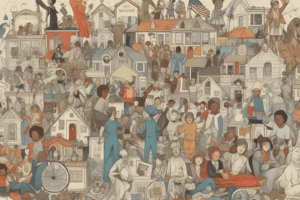Podcast
Questions and Answers
Where do the boys live?
Where do the boys live?
in an orphanage
Where does the woman tell Buddy he will be going?
Where does the woman tell Buddy he will be going?
to a foster home; the Amoses
What is Bud's reaction to the news of moving?
What is Bud's reaction to the news of moving?
He is upset, but doesn't cry anymore. Instead, his nose gets runny and his throat gets choky and his eyes get stingy.
What does Bud think about where Jerry is going?
What does Bud think about where Jerry is going?
Why is losing a tooth such a traumatic event for Buddy?
Why is losing a tooth such a traumatic event for Buddy?
How is being 6 years old a turning point in kids' lives according to Bud?
How is being 6 years old a turning point in kids' lives according to Bud?
What does the blue flyer say that impresses Buddy?
What does the blue flyer say that impresses Buddy?
Why does Bud keep the flyer in his suitcase?
Why does Bud keep the flyer in his suitcase?
What does Bud mean by "Here we go again" at the end of the chapter?
What does Bud mean by "Here we go again" at the end of the chapter?
Study Notes
Living Situation
- Boys reside in an orphanage.
Foster Care Transition
- Buddy is informed he will be sent to a foster home, specifically to the Amoses.
Emotional Response
- Buddy feels upset upon hearing the news but does not cry anymore; he experiences a runny nose, a choky throat, and stinging eyes.
Comparisons to Others
- Buddy believes that Jerry's situation will be preferable; he perceives a foster home with girls as less threatening than the older boy he is aware of in the Amoses' house.
Tooth Loss Trauma
- Losing a tooth signifies a traumatic experience for Buddy; he fears being placed in a dangerous situation with an older boy, contrasting Jerry’s potential dress-up situation.
Turning Point of Age Six
- Age six marks a significant change in how adults interact with children, treating them more like adults with stricter discipline, and it is a pivotal time for losing baby teeth, causing fear.
The Blue Flyer
- The flyer features an announcement for "Herman E. Calloway and the Dusky Devastators of the Depression," emphasizing its importance with six exclamation points, catching Buddy's attention.
Keeping the Flyer
- Buddy keeps the flyer in his suitcase because he believes the person in the picture might be his father, driving his desire to find him.
Recurring Patterns
- Buddy’s repeated phrase "Here we go again" suggests a cycle of disappointment and familiarity with his difficult experiences, ending the chapter on a note of resignation.
Studying That Suits You
Use AI to generate personalized quizzes and flashcards to suit your learning preferences.
Description
This quiz explores the emotional complexities faced by Buddy as he transitions from an orphanage to a foster home. It examines his feelings of fear, trauma, and comparisons to his peers, particularly regarding his experience of losing a tooth and the changes at age six. Dive into Buddy's world and understand the challenges of foster care.




